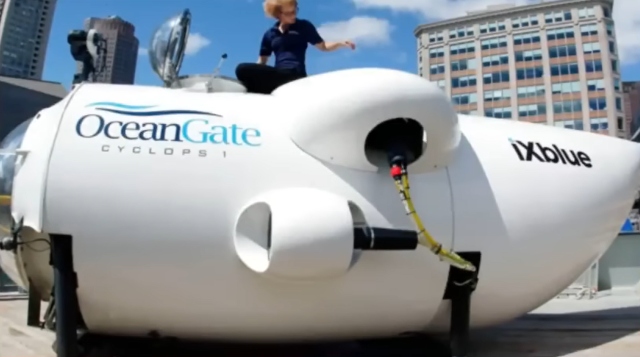Harvard scientists believe debris of unidentified object found near Papua New Guinea could be remains of INTERSTELLAR SPACECRAFT
07/12/2023 / By Kevin Hughes

Two “alien hunter” scientists from Harvard University believe small metal fragments recovered from an unidentified flying object that crashed in the Pacific to be “artificial in origin.”
The Harvard pair recovered around 50 unusual iron spheres after tracking down an unidentified object, known as IM1, off the coast of Papua New Guinea as part of a $1.5 million underwater search mission. (Related: Harvard physicist wants to prove METEORITE that fell near Papua New Guinea is an ALIEN PROBE.)
Avi Loeb, former chair of Harvard’s astronomy department who headed the research, noted that the latest lab analysis of the metal spheres revealed they are “anomalous” and stronger than any observed meteor produced by nature.
“This composition is anomalous compared to human-made alloys, known asteroids and familiar astrophysical sources,” said Loeb.
The National Aeronautics and Space Administration said IM1 clearly came from outer space, which makes it Earth’s first known interplanetary visitor. It crashed into the ocean in 2014, but its fragments were not discovered until the research conducted by Loeb and fellow Harvard researcher Amir Siraj.
IM1 is probably part of an “interstellar spacecraft”
The Harvard pair asserted their latest findings support the possibility that IM1 was “artificial in origin” and that it was part of an “interstellar spacecraft” created by extraterrestrial beings.
“It’s really important to continue pushing the boundary in terms of destigmatizing the search for extraterrestrial life. If you don’t consider a possibility, you usually won’t discover something new,” said Siraj, who first found IM1.
IM1 withstood four times the pressure that would usually destroy an ordinary iron-metal meteor as it plunged through Earth’s atmosphere at a speed of 100,215 miles per hour.
Iron is already a popular major ingredient in the hardest known types of natural meteors, so the Harvard researchers theorized that there must be something really extraordinary about how the object was built.
And now a number of tests on the retrieved IM1 fragments carried out at a research laboratory in Berkeley, California, has proven that their chemical make-up is predominantly iron, providing even more proof in favor of the Harvard pair’s theory regarding its extraterrestrial origins.
“More than 95 percent of all meteorites contain iron-nickel metal. As a consequence, meteorites have concentrations of nickel that are much greater than that of nearly any terrestrial rock,” Loeb said.
In contrast to these standard iron-nickel meteorites, the IM1 fragments contained only “negligible” amounts of nickel, alongside other “trace elements.” In this type of scientific analysis, trace elements refer to chemical compounds or atomic elements that exist only in fleetingly tiny quantities, lower than 100 parts per million.
The Harvard team guaranteed that the 50 spherical iron fragments dug up from over a mile beneath the surface of the Pacific were actually real remains from IM1.
Initially, Siraj cut down the final trajectory of IM1 as it exploded into flames on its way toward the ocean, tracing its airbursts with Department of Defense satellite data and local seismometers established to monitor earthquakes and volcanic activity.
With confidence that the eventual path for IM1 covered 6.2 square miles of the ocean near Manus Island in Papua New Guinea, the team was then able to scratch the deep ocean floor with a huge magnetic “sled” both along IM1’s path and some control regions, which served as a control to make sure more iron spheres or spherules did not find their way onto the ocean floor by way of any event unconnected to IM1’s fall to Earth.
“The spherules were mostly found along the expected meteor path,” wrote Loeb and Siraj in their research. The report said the unusual iron composition of the spheres “indicates a common source,” which they assert is “different from background spherules found in control regions.”
Follow UFOs.news for more news about UFOs and other extraterrestrial objects.
Watch this clip from “Rising” on The Hill TV featuring an interview with Loeb discussing his findings about IM1.
This video is from the PureTrauma357 channel on Brighteon.com.
More related stories:
Sen. Marco Rubio: Senior government officials have first-hand knowledge of secret UFO programs.
Former intelligence official: US has at least a dozen alien spacecraft in its possession.
NASA will find alien life in the next 25 years, experts predict.
Sources include:
Submit a correction >>
Tagged Under:
aliens, Amir Siraj, Avi Loeb, breakthrough, cosmic, discoveries, extraterrestrials, future science, future tech, Harvard, IM1, interstellar spacecraft, metals, meteor, meteorite, real investigations, research, Space, space tourism, UFO, unidentified flying objects
This article may contain statements that reflect the opinion of the author
RECENT NEWS & ARTICLES
COPYRIGHT © 2017 FUTURETECH.NEWS
All content posted on this site is protected under Free Speech. FutureTech.news is not responsible for content written by contributing authors. The information on this site is provided for educational and entertainment purposes only. It is not intended as a substitute for professional advice of any kind. FutureTech.news assumes no responsibility for the use or misuse of this material. All trademarks, registered trademarks and service marks mentioned on this site are the property of their respective owners.




















